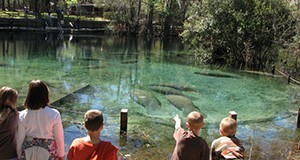Abstract
Early childhood is a crucial period for the physical and cognitive development of children. Most people who care for young children realize that children benefit from playing outside, but caretakers might not have ready access to the literature that supports their observations. This 4-page fact sheet reviews some of the literature that shows that young children need to go outside and be around nature regularly. It describes some of the benefits children (and adults!) gain from learning and playing outdoors and includes suggestions for several resources for parents, teachers, and caretakers who hope to increase these opportunities for their youngsters. Written by Kristen Poppell and Martha C. Monroe, and published by the School of Forest Resources and Conservation, October 2015.
FOR326/FR394: Why is Exposure to Nature Important in Early Childhood? (ufl.edu)
References
Ernst, J. 2012. "Early childhood nature play: A needs assessment of Minnesota licensed childcare providers." Journal of Interpretation of Research. 17(1) 7-24. https://doi.org/10.1177/109258721201700102
Lieflander, A. K., and F. X. Bogner. 2014. "The effects of children's age and sex on acquiring pro-environmental attitudes through environmental education." The Journal of Environmental Education. 45(2), 105-117. https://doi.org/10.1080/00958964.2013.875511
Loprinzi, P., B. Cardinal, K. Loprinzi, and H. Lee. 2010. "Benefits and environmental determinants of physical activity in children and adolescents." Obesity Facts. 5, 567-610. https://doi.org/10.1159/000342684
Louv, R. 2005. Last Child in the Woods, New York City, NY: Algonquin Books.
McCurdy, L., K. Winterbottom, S. Mehta, and J. Roberts. 2010. "Using nature and outdoor activity to improve children's health." Current problems in pediatric and adolescent health care. 40(5) 102-117. https://doi.org/10.1016/j.cppeds.2010.02.003
NAAEE (North American Association for Environmental Education). 2015. What is Environmental Education? Retrieved from http://www.naaee.net/what-is-ee
NAAEE (North American Association for Environmental Education). 2010. Early Childhood Environmental Education Programs: Guidelines for Excellence. Washington, DC: North American Association for Environmental Education.
NLI (Natural Learning Initiative). January 2012. Benefits of connecting children with nature: Why naturalize outdoor learning environments. Retrieved from http://naturalearning.org/sites/default/files/Benefits%20of%20Connecting%20Children%20with%20Nature_InfoSheet.pdf
Olshansky, S., D. Passaro, R. Hershow, J. Layden, B. Carnes, J. Brody, L. Hayflick, R. Butler, D. Allison, and D. Ludwig. 2005. "A potential decline in life expectancy in the United States in the 21st century." The New England Journal of Medicine. 352(11) 1138-1145. https://doi.org/10.1056/NEJMsr043743
Perrin, J., S. Blooms, and S. Gortmaker. 2007. "The increase of childhood chronic conditions in the United States." Journal of the American Medical Association. 297(24) 2755-2759. https://doi.org/10.1001/jama.297.24.2755
Taylor, A. F., and F. E. Kuo. 2009. "Children with attention deficits concentrate better after walk in the park." Journal of Attention Disorders. 12(5) 402-409. https://doi.org/10.1177/1087054708323000
Torquati, J., K. Cutler, D. Gilkerson, and S. Sarver. 2013. "Early childhood educators' perceptions of nature, science, and environmental education." Early Education and Development. 24(5) 721-743. https://doi.org/10.1080/10409289.2012.725383
UNESCO (United Nations Educational, Scientific and Cultural Organization). (2015). Early Childhood Care and Education. Retreived from http://www.unesco.org/new/en/education/themes/strengthening-education-systems/early-childhood/
Wells, N., and G. W. Evans. 2003. Nearby nature: A buffer of life stress among rural children. Environment and Behavior 35(3) 311-330. https://doi.org/10.1177/0013916503035003001
Wilson, R. A., (1996). Starting early: Environmental education during the early childhood years. ERIC Digest. p. 1-6. Retrieved from www.eric.ed.gov

